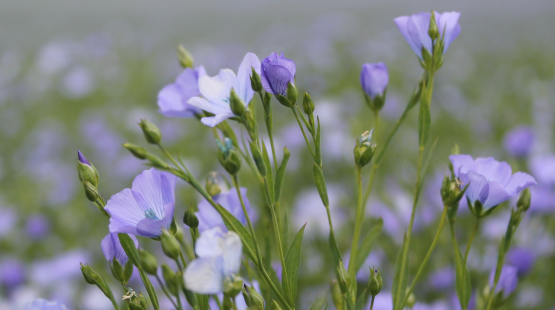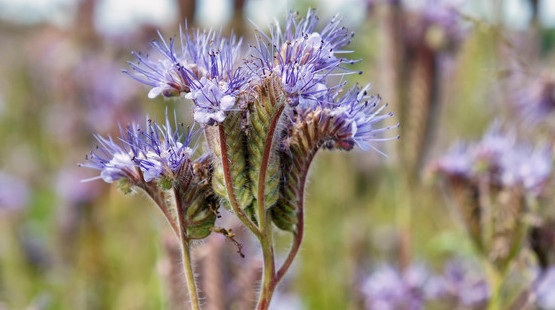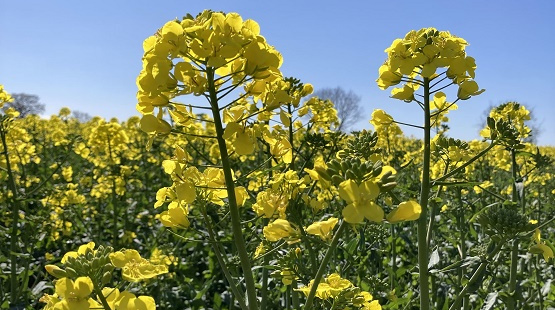Winter Linseed Agronomy

Agronomy
Anywhere in the UK.
Winter Linseed can be grown on all soil types.
Drilling date is from early September through to early October, depending on your location.
12cm – 30cm.
Drill into moisture at 2cm - 3cm depth. Winter Linseed requires a firm seed bed which means that min-till or direct drilling are ideal.
30 to 35 kg/ha depending on variety.

During mild winters, forward crops can be prone to lodging. Toprex has an EAMU for use on linseed. Toprex is a very powerful growth regulator for Linseed also providing some fungicidal activity. The fungicides Meconazole and Tebuconazole are widely used on Winter Linseed, both having some growth regulatory effect. See the EAMU box for product links.
Winter Linseed is not affected by flea beetles. Cabbage stem flea beetle that is such a threat to OSR does not affect linseed. CSFB only attack brassicas - Linseed is NOT a Brassica. Slug control is unlikely in the autumn. Pigeons favour OSR over Winter Linseed, so crops are only susceptible for a short period in the spring. The powers of recovery are at least as good as OSR.
A slug survey of 125 growers who grew Wheat after OSR and Winter Linseed provided a stark contrast in slug control.
The main diseases of Winter Linseed are Kabatellia in the autumn, Septoria in spring and Botrytis during flowering. Kabatiella Linicola is a disease similar to Phoma in OSR and poses a risk to untreated Winter Linseed. Previous cropping does not influence disease incidence and control is preventative only, so all crops should receive an application of Difenoconazole, Metconazole and Tebuconazole.
Paclobutrazol (Toprex) provides good follow up to Kabatellia control, with excellent Septoria control and a PGR benefit when applied in the early spring. See the EAMU box for product links.
50 kg/ha P&K
80 - 130 kg/ha N (which is nearly half that used on OSR).
No seed bed Nitrogen is used; the first application will typically be March.
Only required if problems are known to exist.
Average height of 70cm.
The best Winter Linseed variety is Attila and Alpaga. Attila is a new variety exclusive to Premium Crops. It was registered in 2021 and currently performs on average 20% above predecessor Alpaga in commercial yields with greater agronomic traits.
Winter Linseed is ready for combining typically mid-July to early August. In the Southern half of the country this can often be before WOSR. Regular Linseed growers will tell you that they harvest Linseed faster than any other crop. How do they do this? By taking the earliest opportunity to harvest - even if the stems are still green (in fact Linseed straw is MUCH less likely to cause combining issues going at this stage rather than when it is "weathered" and the fibre separates away from the stem). NEVER leave Winter Linseed until after your Winter Wheat.
Only Glyphosate can be used on commercial grain crops to dessicate. See the EAMU box for product links.
Winter Linseed is not inclined to shed or shatter like OSR. The knife needs to be in good condition and to be sat tight on the fingers to ensure a good "shearing" action.
Most combines handle Linseed well, however occasional reports of Linseed straw wrapping around the rear rotor of CLAAS Lexion combines have been brought to our attention. Our understanding is that the rear of the non modified rotor has rubber "paddles" attached to it. Linseed straw can snag on these and tear them off. This wrapping is made much worse if the straw is weathered (as above). The modified rotor has metal paddles which prevents the wrapping.
Models built post 2013 were built as standard with a pair of Linseed rotors. A retrofit kit is available.
If you have a pre 2013 CLAAS Lexion (or intend to buy second hand) please check with your local CLAAS dealer about this modification.
See Combining Instructions in the Useful Links box below.
Contract dependant. Requirements differ based on end use.
Likely range 2.5 - 3.2 t/ha (1.0 - 1.3 t/ac).
Because harvesting takes place in mid-July/early August, Winter Linseed straw is dry and is much more likely to be chopped on the combine than Spring Linseed straw, plus the chopper blades are newer!
Linseed straw is exempt from burning bans. The most common method is to either push the straw into heaps, or easier still, bale in round bales and set alight. Linseed straw burns very hot and clean with very little ash residue. Linseed straw is ideal for on-farm straw burners. It is not liked by the straw burning power stations because perversely - it burns too hot!
Winter Linseed will typically be harvested between 7.5% to 10% moisture. With market standards being basis 9% maximum 10%, most crops do not need to be dried.
If drying is required it can be handled in any system that handles OSR, with similar temperature settings. Care needs to be taken when drying Linseed on-floor or in a bin system. Linseed, being a flat seed has a very high resistance to airflow, so the drying front can stall after about a metre or so, resulting in a hard, wet layer. To avoid this, do not dry linseed on-floor above a metre in depth, or in a bin system you will need to rotate with an empty bin. For a Protimeter Linseed conversion chart click here.
Fully Approved Products for Linseed
Links are provided below to the Authorisation document for each of the products.
This list is not exhaustive - for a complete list of products approved for Spring Linseed please visit the HSE database.
All products below were Authorised at the time they were added to this list, while Premium Crops do regularly check the validity of the products and update the list accordingly, it remains the Grower's responsibility to make sure that the Authorisation remains valid at the time any product is used.
Afrisect 500 EC (cypermethrin) Agriphar S.A.
Ally SX FMC Agro Limited
Dow Shield 400 Corteva Agriscience UK Limited
Eagle Interfarm UK Limited
Eagle Sumitomo Chemical (UK) Plc
Eagle Bayer CropScience Limited
Fusilade Forte (fluazifop-P-butyl) Nufarm UK Ltd
Fusilade Max (fluazifop-P-butyl) NuFarm UK Ltd MAPP NO. 19013
Jubilee SX FMC Agro Limited
Laya (metsulfuron-methyl) Life Scientific Limited
Roundup Biactive Monsanto (UK) Limited
Roundup Biactive GL Monsanto (UK) Limited
Roundup Energy Monsanto (UK) Limited
Roundup Flex Monsanto (UK) Limited
Roundup Klik Monsanto (UK) Limited
Roundup Metro XL Monsanto (UK) Limited
Roundup POWERMAX Monsanto (UK) Limited
Permasect 500 EC Arysta LifeScience Benelux SPRL
Supasect 500 EC (cypermethrin) Agriphar S.A.
EAMUs for Winter Linseed
Detailed below are the products listed by the Health and Safety Executive as having an Extension of Authorisation for a Minor Use of a Plant Protection Product. (EAMU)
It is essential that anyone who needs to use a product in accordance with an Extension of Authorisation must read the text of the Extension of Authorisation before commencing any spraying operation. Links are provided below to the Authorisation document for each of the products.
All products below were Authorised at the time they were added to this list, while Premium Crops do regularly check the validity of the products and update the list accordingly, it remains the Grower's responsibility to make sure that the Authorisation remains valid at the time any product is used.
Ambarac (metconazole) Life Scientific Limited
Avadex Excel 15G (tri-allate) Gowan Comercio Internacional e Servicos Limitada
Avadex Factor (tri-allate) Gowan Crop Protection Ltd
Balistik (clethodim) Arysta LifeScience Great Britain Ltd
Basilico (mesotrione) Life Scientific MAPP 18028 final use by 28/02/2025
Basilico (mesotrione) Life Scientific MAPP 19927
Butisan S (metazachlor) BASF Plc
Calisto (Mesotrione) Syngenta Crop Protection UK Ltd MAPP 1232 final use by 28/02/2025
Calisto (Mesotrione) Syngenta Crop Protection UK Ltd MAPP 19756
Caramba (metconazole) BASF Plc
Centurion Max (clethodim) Interfarm UK Ltd
Clayton Comply (prosulfocarb) Clayton Plant Protection Ltd
CleanCrop Corsair (lambda-cyhalothrin) Agrii, a trading name of Masstock Arable (UK) Ltd
Defy (prosulfocarb) Syngenta (UK) Ltd
Devrinol (napropamide) UPL Europe Ltd
Difcor 250EC (difenoconazole) Q-CHEM nv
Difenostar (difenoconazole) Life Scientific Limited
Filan (Boscalid) BASF plc
Hallmark with Zeon Technology (lambda-cyhalothrin) Syngenta UK Ltd
Juventus (metconazole) BASF plc
Katamaran (metazachlor) BASF plc
Klartan (tau-fluvalinate) Adama Agricultural Solutions UK Ltd
Lambdastar (l lambda-cyhalothrin) Life Scientific Limited
Makila 500 SC (metazachlor) Novastar Link Limited
Markate 50 (lambda-cyhalothrin) Agrovista UK Ltd
Mavrik (tau-fluvalinate) Adama Agricultural Solutions UK Ltd
Maxim 480FS (fludioxonil) Syngenta UK Limited
Metaz 500 (metazachlor) Novastar Link Limited
Metazacare (metazachlor) AGROCARE Chemichals Kft
Metfin 90 (metconazole) Clayton Plant Protection Limited
Proline 275 (prothioconazole) Bayer CropScience Ltd
Quidam (prosulfocarb) UPL Europe Ltd
Rapsan Solo (metazachlor) Belchim Crop Protection Limited
Rapsan Solo (metazachlor) Certis Belchim B.V.
Select Prime (clethodim) Arysta LifeScience SAS
Sultan 50 SC (metazachlor) Adama Agricultural Solutions UK Ltd
Sunorg Pro (metconazole) BASF plc
Toprex (difenoconazole and paclobutrazol) Syngenta UK Ltd
The above is a list of all products listed on the HSE website and as such does not represent Premium Crops' endorsement or recommendation for use.
Please note an EAMU does not ensure a product is safe to use.
Emergency Authorisation
Emergency Approvals (EA) have been granted for desiccant Spotlight Plus to use on linseed seed production crops only until the 30th September 2024.
Any usage must comply with the stewardship rules, viewable here.
A record of use form must be completed and sent to uk.stewardship@fmc.com by 31st December 2024.
Visitors also searched for
HEAR
High Erucic Acid Rapeseed - The most profitable way to grow OSR.










